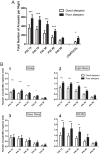Temporal relations between peripheral and central arousals in good and poor sleepers
- PMID: 35696573
- PMCID: PMC9231500
- DOI: 10.1073/pnas.2201143119
Temporal relations between peripheral and central arousals in good and poor sleepers
Abstract
Good sleepers and patients with insomnia symptoms (poor sleepers) were tracked with two measures of arousal; conventional polysomnography (PSG) for electroencephalogram (EEG) assessed cortical arousals, and a peripheral arterial tonometry device was used for the detection of peripheral nervous system (PNS) arousals associated with vasoconstrictions. The relationship between central (cortical) and peripheral (autonomic) arousals was examined by evaluating their close temporal dynamics. Cortical arousals almost invariably were preceded and followed by peripheral activations, while large peripheral autonomic arousals were followed by cortical arousals only half of the time. The temporal contiguity of these two types of arousals was altered in poor sleepers, and poor sleepers displayed a higher number of cortical and peripheral arousals compared with good sleepers. Given the difference in the number of peripheral autonomic arousals between good and poor sleepers, an evaluation of such arousals could become a means of physiologically distinguishing poor sleepers.
Keywords: arousal; autonomic; cortical; insomnia; sympathetic.
Conflict of interest statement
The authors declare no competing interest.
Figures






Similar articles
-
Autonomic arousal index: an automated detection based on peripheral arterial tonometry.Sleep. 2002 Aug 1;25(5):543-9. Sleep. 2002. PMID: 12150321
-
Spontaneous arousability in prone and supine position in healthy infants.Sleep. 2006 Jun;29(6):785-90. doi: 10.1093/sleep/29.6.785. Sleep. 2006. PMID: 16796217
-
EEG beta power and heart rate variability describe the association between cortical and autonomic arousals across sleep.Auton Neurosci. 2016 Jan;194:32-7. doi: 10.1016/j.autneu.2015.12.001. Epub 2015 Dec 3. Auton Neurosci. 2016. PMID: 26681575
-
The nature of arousal in sleep.J Sleep Res. 2004 Mar;13(1):1-23. doi: 10.1111/j.1365-2869.2004.00388.x. J Sleep Res. 2004. PMID: 14996030 Review.
-
[Cortical arousal, autonomic arousal. Evaluation techniques and clinical importance].Rev Neurol (Paris). 2003 Nov;159(11 Suppl):6S107-12. Rev Neurol (Paris). 2003. PMID: 14646811 Review. French.
Cited by
-
Modeling Emotional Arousal With Turbulence Measured by EEG.Psychophysiology. 2025 Jun;62(6):e70093. doi: 10.1111/psyp.70093. Psychophysiology. 2025. PMID: 40542499 Free PMC article.
References
-
- Pfaff D., Brain Arousal and Information Theory: Neural Genetic Mechanisms (Harvard University Press, 2006).
-
- Pfaff D., Ribeiro A., Matthews J., Kow L. M., Concepts and mechanisms of generalized central nervous system arousal. Ann. N. Y. Acad. Sci. 1129, 11–25 (2008). - PubMed
-
- Pfaff D. W., Martin E. M., Ribeiro A. C., Relations between mechanisms of CNS arousal and mechanisms of stress. Stress 10, 316–325 (2007). - PubMed
Publication types
MeSH terms
Grants and funding
LinkOut - more resources
Full Text Sources
Medical

